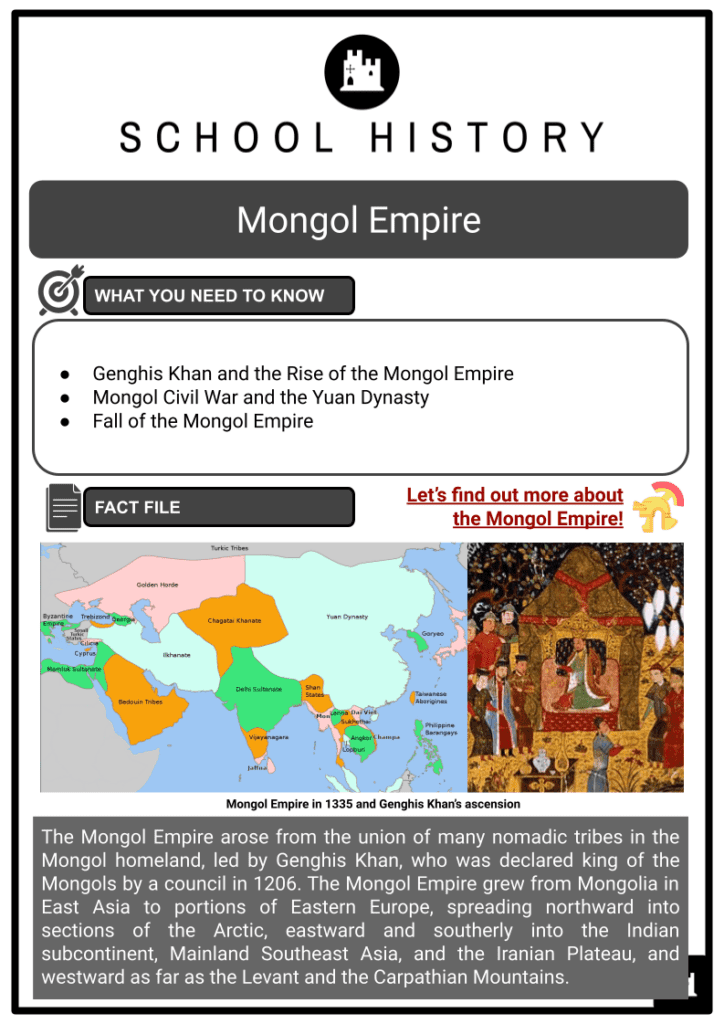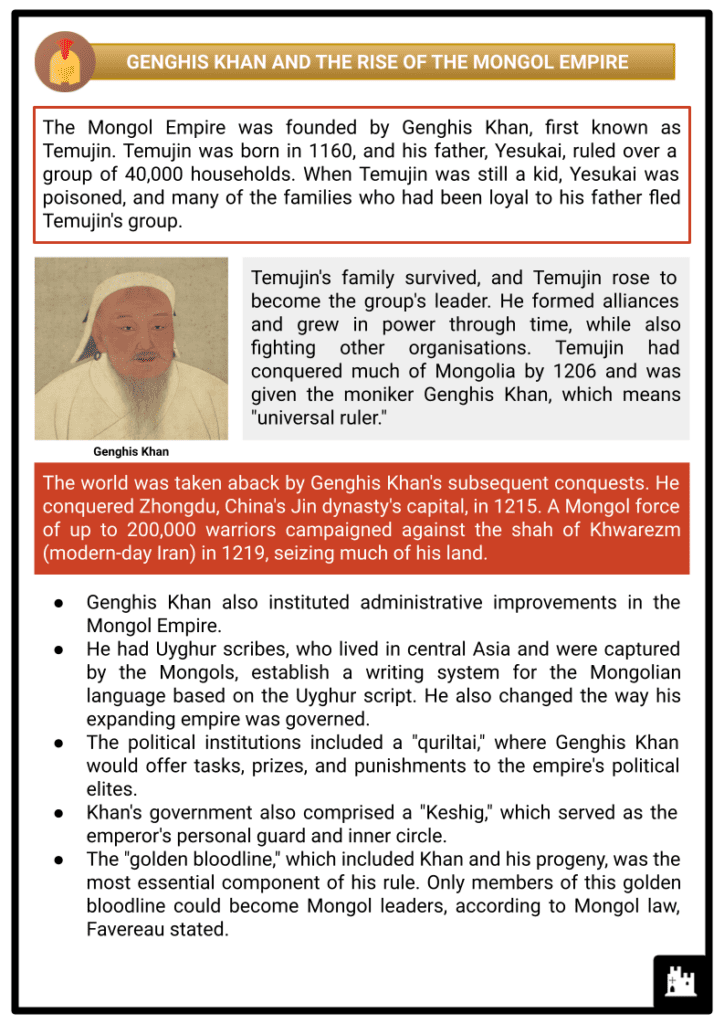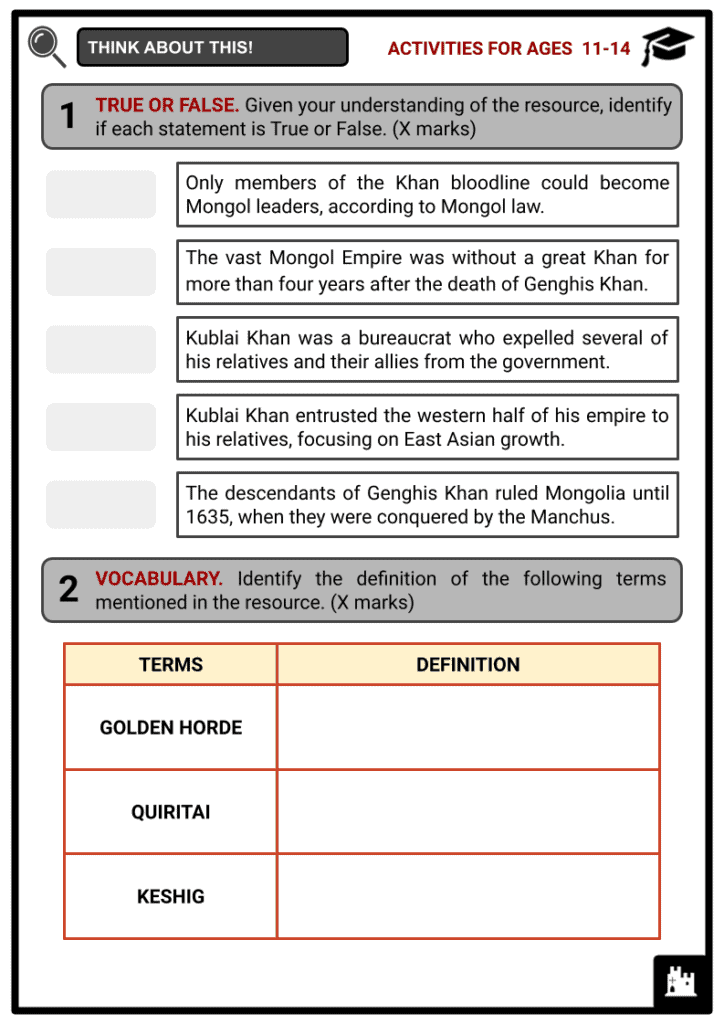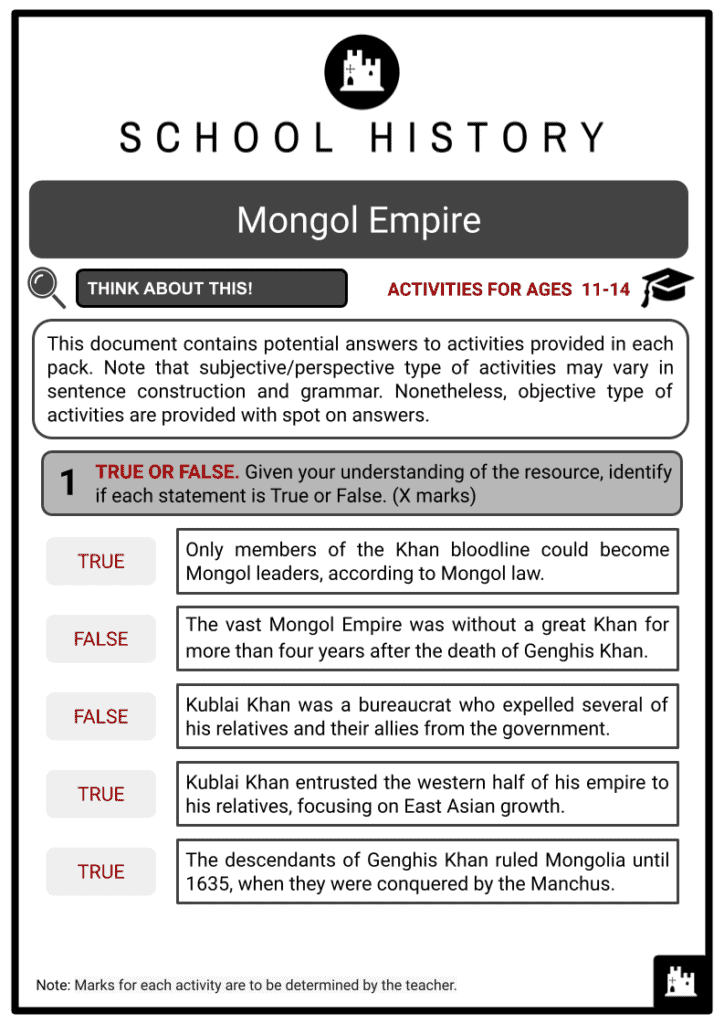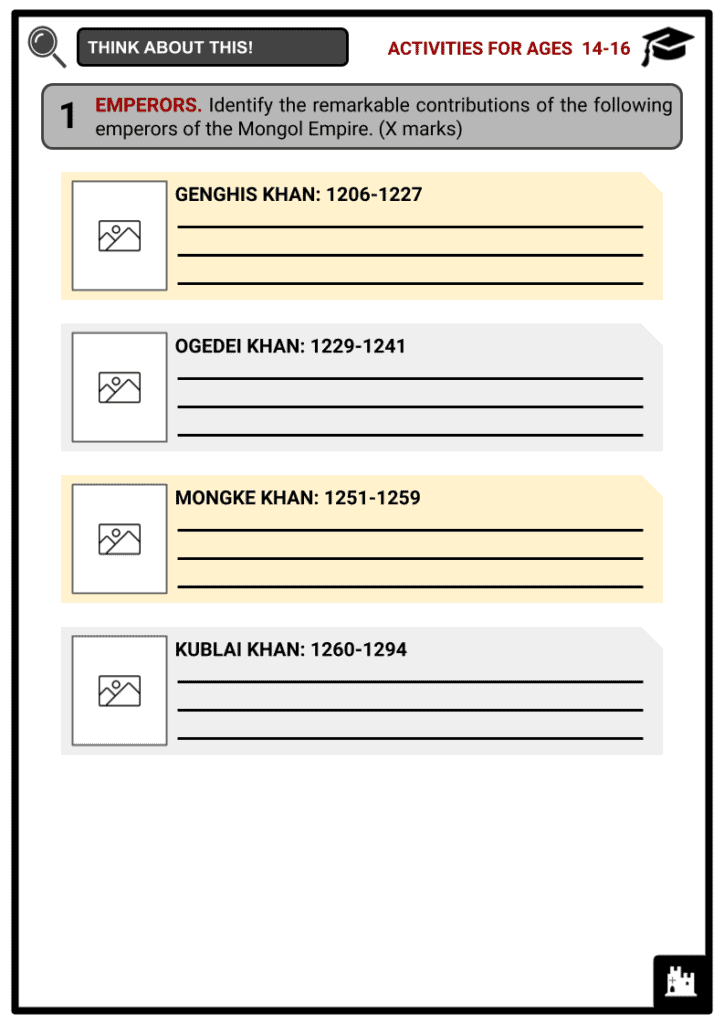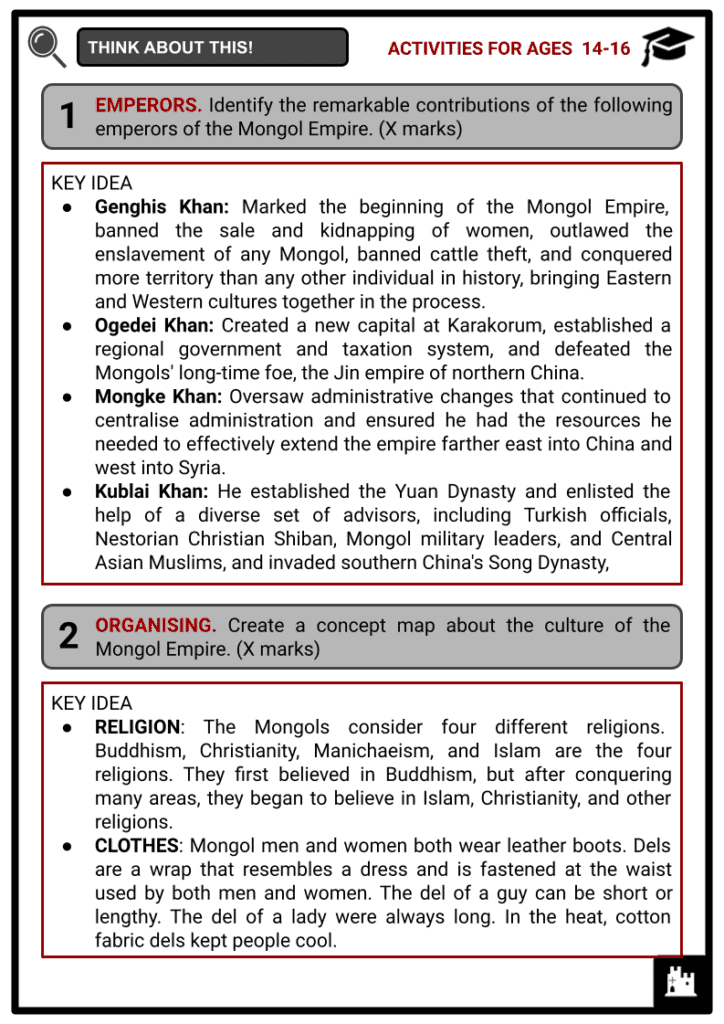Mongol Empire Worksheets
Do you want to save dozens of hours in time? Get your evenings and weekends back? Be able to teach about the Mongol Empire to your students?
Our worksheet bundle includes a fact file and printable worksheets and student activities. Perfect for both the classroom and homeschooling!
Summary
- Genghis Khan and the Rise of the Mongol Empire
- Mongol Civil War and the Yuan Dynasty
- Fall of the Mongol Empire
Key Facts And Information
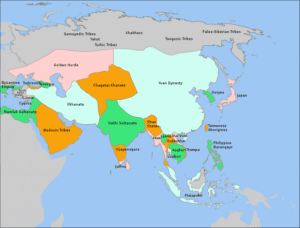
Let’s find out more about the Mongol Empire!
The Mongol Empire arose from the union of many nomadic tribes in the Mongol homeland, led by Genghis Khan, who was declared king of the Mongols by a council in 1206. The Mongol Empire grew from Mongolia in East Asia to portions of Eastern Europe, spreading northward into sections of the Arctic, eastward and southerly into the Indian subcontinent, Mainland Southeast Asia, and the Iranian Plateau, and westward as far as the Levant and the Carpathian Mountains.
GENGHIS KHAN AND THE RISE OF THE MONGOL EMPIRE
- The Mongol Empire was founded by Genghis Khan, first known as Temujin. Temujin was born in 1160, and his father, Yesukai, ruled over a group of 40,000 households. When Temujin was still a kid, Yesukai was poisoned, and many of the families who had been loyal to his father fled Temujin's group.
- Temujin's family survived, and Temujin rose to become the group's leader. He formed alliances and grew in power through time, while also fighting other organisations. Temujin had conquered much of Mongolia by 1206 and was given the moniker Genghis Khan, which means "universal ruler."
- The world was taken aback by Genghis Khan's subsequent conquests. He conquered Zhongdu, China's Jin dynasty's capital, in 1215. A Mongol force of up to 200,000 warriors campaigned against the shah of Khwarezm (modern-day Iran) in 1219, seizing much of his land.
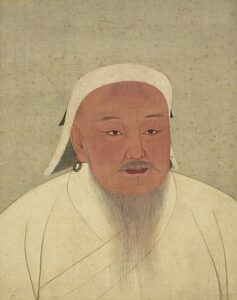
Genghis Khan - Genghis Khan also instituted administrative improvements in the Mongol Empire.
- He had Uyghur scribes, who lived in central Asia and were captured by the Mongols, establish a writing system for the Mongolian language based on the Uyghur script. He also changed the way his expanding empire was governed.
- The political institutions included a "quriltai," where Genghis Khan would offer tasks, prizes, and punishments to the empire's political elites.
- Khan's government also comprised a "Keshig," which served as the emperor's personal guard and inner circle.
- The "golden bloodline," which included Khan and his progeny, was the most essential component of his rule. Only members of this golden bloodline could become Mongol leaders, according to Mongol law, Favereau stated.
- The Mongol Empire expanded under Genghis Khan to include Central Asia, sections of the Middle East, and east to the Korean Peninsula's boundaries. For a while, the Mongols were held at bay by the heartlands of India and China, as well as Korea's Goryeo Kingdom.
- Genghis Khan died in 1227, leaving his kingdom divided into four khanates administered by his sons and grandsons. The Golden Horde Khanate in Russia and Eastern Europe, the Ilkhanate in the Middle East, the Chagatai Khanate in Central Asia, and the Great Khanate in Mongolia, China, and East Asia were among them.
MONGOL CIVIL WAR AND THE YUAN DYNASTY
- The Kuriltai chose Ogedei, Genghis Khan's third son, as his successor in 1229. The new great Khan continued to extend the Mongol empire in all directions, as well as establishing a new capital city in Mongolia, Karakorum. In East Asia, the Jin Dynasty, which was ethnically Jurchen, perished in 1234; the Song Dynasty, on the other hand, lasted. Ogedei's armies invaded Eastern Europe, seizing Rus city-states and principalities, including Kiev, the capital. By 1240, the Mongols had also conquered Persia, Georgia, and Armenia.
- Ogedei Khan died in 1241, halting the Mongol conquests of Europe and the Middle East for the time being. When word of Ogedei's death arrived, Batu Khan's command was prepared to invade Vienna. The majority of the Mongol nobles rallied around Guyuk Khan, Ogedei's son, but his uncle declined to attend the kurultai. The vast Mongol Empire was without a great Khan for more than four years.
- Guyuk Khan died only two years later, in 1248, of either alcoholism or poisoning, depending on which version one believes. Once again, the imperial family had to pick a successor from among all of Genghis Khan's sons and grandsons, and reach an agreement throughout their vast kingdom. Mongke Khan, grandson of Genghis and son of Tolui, was officially chosen as the new great Khan at a 1251 kurultai.
- Mongke Khan was a bureaucrat who expelled several of his relatives and their allies from the government in order to cement his own authority and modernise the tax system.
- Between 1252 and 1258, he conducted an empire-wide census. The Mongols, on the other hand, continued to expand in the Middle East under Mongke, as well as seeking to invade the Song Chinese.
- Mongke Khan died in 1259 while fighting the Song, and the Mongol Empire required a new leader once more. Hulagu Khan's army, who had beaten the Assassins and ravaged the Muslim Caliph's city of Baghdad, were defeated by the Egyptian Mamluks in the Battle of Ayn Jalut while the royal family argued succession.
- The Mongols would never resume their westward push, but East Asia would be a different issue.
- Different Mongol leaders picked opposing sides and started to fight. Böke was compelled to surrender in 1263. While Kublai Khan was victorious, he was not acknowledged as the Great Khan by all of the Mongol leaders, and he was unable to rule over the whole Mongol Empire.
- The Mongol Empire went into civil war this time, with another of Genghis Khan's grandchildren, Kublai Khan, assuming control. After a bloody struggle, he defeated his cousin Ariqboqe and took control of the empire in 1264.
- In 1271, the great Khan declared himself the founder of China's Yuan Dynasty and set out to conquer the Song Dynasty. In 1276, the final Song emperor surrendered, completing the Mongol conquest of China. Following more conflicts and diplomatic intimidation, Korea was also obliged to pay tribute to the Yuan.
- Kublai Khan entrusted the western half of his empire to his relatives, focusing on East Asian growth. He forced Burma, Annam (northern Vietnam), Champa (southern Vietnam), and the Sakhalin Peninsula to become Yuan China's tributaries. His costly invasions of Japan in 1274 and 1281, as well as Java (now part of Indonesia) in 1293, were a complete failure.
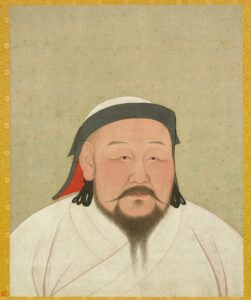
Kublai Khan - Kublai Khan died in 1294, and the Yuan Empire passed to Temur Khan, Kublai's grandson, without a kurultai. This was a clear indication that the Mongols were getting extremely Sinofied. Ghazan, the next Mongol ruler of the Ilkhanate, turned to Islam. The Chagatai Khanate of Central Asia and the Ilkhanate, which was backed by the Yuan, went to war.
FALL OF THE MONGOL EMPIRE
- The Mongol empire that dominated parts of Europe was described as the "Golden Horde." It ruled over areas of Eastern Europe, the Caucasus, and western Russia in 1263. The Golden Horde was occasionally at odds with the Ilkhanate and the Chagatai Khanate, two other Mongol empires that arose following the civil war, according to Favereau.
- According to Favereau, the Golden Horde maintained strong connections with European countries like as the Italian state of Genoa, and frequently utilised the Genoese as commercial middlemen. The Golden Horde also attempted to exert authority over the princes of the places it conquered, like as Moscow, and to use them as tax collectors. The princes worked effectively with the Golden Horde at times, but they also staged rebellions that the Golden Horde had to put down at other times.
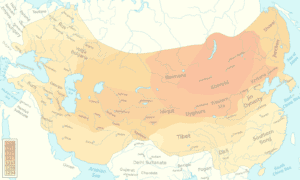
Expansion of the Mongol Empire - The Mongols lost control of Persia in 1335. The Black Death spread over Central Asia, wiping out entire cities along Mongol trade routes. In the 1350s, Goryeo Korea defeated the Mongols. The Golden Horde had lost Belarus and Ukraine to the west by 1369; in the meantime, the Chagatai Khanate had dissolved, and local warlords had stepped in to fill the hole. Most importantly, the Yuan Dynasty was ousted in China in 1368 by the ethnic Han Chinese Ming Dynasty.
- The descendants of Genghis Khan ruled Mongolia until 1635, when they were conquered by the Manchus. However, after less than 150 years in existence, their mighty domain, the world's biggest contiguous land empire, fell apart in the fourteenth century.

